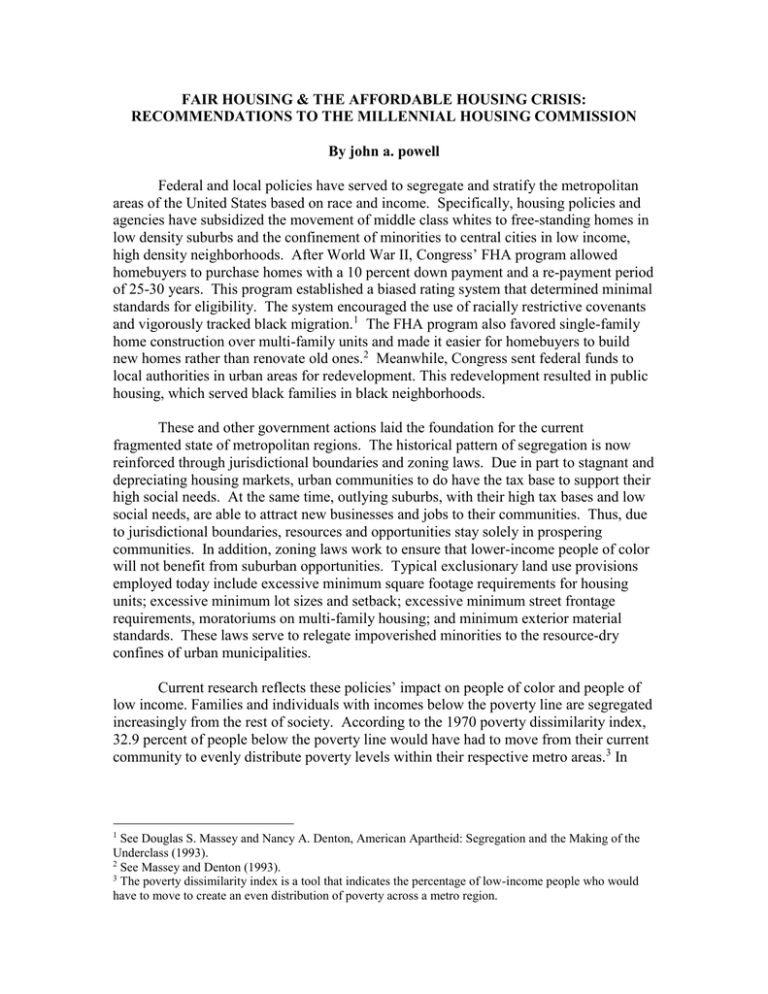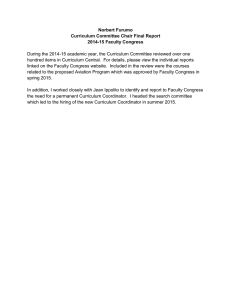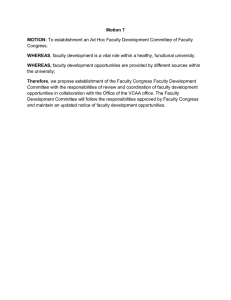FAIR HOUSING & THE AFFORDABLE HOUSING CRISIS:
advertisement

FAIR HOUSING & THE AFFORDABLE HOUSING CRISIS: RECOMMENDATIONS TO THE MILLENNIAL HOUSING COMMISSION By john a. powell Federal and local policies have served to segregate and stratify the metropolitan areas of the United States based on race and income. Specifically, housing policies and agencies have subsidized the movement of middle class whites to free-standing homes in low density suburbs and the confinement of minorities to central cities in low income, high density neighborhoods. After World War II, Congress’ FHA program allowed homebuyers to purchase homes with a 10 percent down payment and a re-payment period of 25-30 years. This program established a biased rating system that determined minimal standards for eligibility. The system encouraged the use of racially restrictive covenants and vigorously tracked black migration.1 The FHA program also favored single-family home construction over multi-family units and made it easier for homebuyers to build new homes rather than renovate old ones.2 Meanwhile, Congress sent federal funds to local authorities in urban areas for redevelopment. This redevelopment resulted in public housing, which served black families in black neighborhoods. These and other government actions laid the foundation for the current fragmented state of metropolitan regions. The historical pattern of segregation is now reinforced through jurisdictional boundaries and zoning laws. Due in part to stagnant and depreciating housing markets, urban communities to do have the tax base to support their high social needs. At the same time, outlying suburbs, with their high tax bases and low social needs, are able to attract new businesses and jobs to their communities. Thus, due to jurisdictional boundaries, resources and opportunities stay solely in prospering communities. In addition, zoning laws work to ensure that lower-income people of color will not benefit from suburban opportunities. Typical exclusionary land use provisions employed today include excessive minimum square footage requirements for housing units; excessive minimum lot sizes and setback; excessive minimum street frontage requirements, moratoriums on multi-family housing; and minimum exterior material standards. These laws serve to relegate impoverished minorities to the resource-dry confines of urban municipalities. Current research reflects these policies’ impact on people of color and people of low income. Families and individuals with incomes below the poverty line are segregated increasingly from the rest of society. According to the 1970 poverty dissimilarity index, 32.9 percent of people below the poverty line would have had to move from their current community to evenly distribute poverty levels within their respective metro areas.3 In 1 See Douglas S. Massey and Nancy A. Denton, American Apartheid: Segregation and the Making of the Underclass (1993). 2 See Massey and Denton (1993). 3 The poverty dissimilarity index is a tool that indicates the percentage of low-income people who would have to move to create an even distribution of poverty across a metro region. 1990, the index increased to 36.4 percent.4 Additionally, studies indicate that communities remain racially segregated. According to the Lewis Mumford Center for Comparative Urban and Regional Research, white Americans in metro areas live in neighborhoods that are 83 percent white and 7 percent black. In contrast, black Americans live in neighborhoods that are 33 percent white and as much as 54 percent black.5 Further, black Americans are disproportionately represented in areas of concentrated poverty.6 In central cities, one in three poor African Americans lives in a neighborhood of concentrated poverty, compared with one in twenty poor white Americans.7 Congress has yet to take effective measures to disestablish the racially and economically discriminatory structures that now pervade metropolitan areas. The Fair Housing Act (hereinafter “FHA”), and the body of law that has evolved with its passage, is inadequate to confront the current affordable housing crisis and its disproportionate impact on people of color. Many federal circuits now interpret the FHA to require a showing of intentional discrimination before finding that government action is discriminatory. Because proving intent is a nearly impossible burden, the intent requirement has reduced the FHA’s power to remedy discriminatory practices. Further, even where private plaintiffs can meet the intent standard, the lawsuits often result in cumbersome and ineffective remedies. Thus, legal actions cannot address the structural biases within current policies. If Congress intends to break down the discriminatory structures that it has created over the past sixty years, it must empower federal agencies with the authority and financial resources to address discrimination in a systematic manner.8 The legislature can look to previous acts for guidance. For example, African American voter registration finally began to substantially increase when Congress enacted the Voting Rights Act of 1965.9 Similarly, Congressional empowerment of the Equal Employment Opportunity Commission has had a significant impact on decreasing incidents of employment discrimination.10 In the FHA, however, Congress gave minimal authority to federal agencies to pursue independent federal enforcement efforts.11 For example, the statute 4 See Alan J. Abramson, Mitchell S. Tobin, and Matthew R. VanderGoot, The Changing Geography of Metropolitan Opportunity: The Segregation of the Poor in U.S. Metropolitan Areas, 6 Housing Policy Debate 45, 62 (1995). 5 See Lewis Mumford Center for Comparative Urban and Regional Research, Ethnic Diversity Grows, Neighborhood Integration is at a Standstill (April 3, 2001) available at http://mumford1.dyndns.org/cen2000/WholePop/Wreport/page1.html. 6 Areas of concentrated poverty are those where 40 percent or more residents have incomes below the poverty line. 7 See David Rusk, Inside Game/Outside Game: Winning Strategies for Saving Urban America 71-72, 10506 (1999); john a. powell, Sprawl, Fragmentation and the Persistence of Racial Inequity: Limiting Civil Rights by Fragmenting Space 19 (2001)(forthcoming chapter in Urban Sprawl: Causes, Consequences, and Policy (Gregory Squires, ed.)). 8 See John C. Boger, Toward Ending Residential Segregation: A Fair Share Proposal for the Next Reconstruction, 71 N.C.Rev. 1573, 1585-1586 (1993). 9 Id. at 1586-1587. 10 Id. at 1588. 11 Id. at 1584. limits HUD’s enforcement power to specific circumstances where HUD has reasonable cause to believe a person has engaged in a pattern of resistance, and this pattern raises an issue of public concern.12 Such power is insufficient to adequately address fair housing concerns. In drafting effective legislation, Congress must also investigate the relationships between housing, employment, and education. Opportunities for housing, employment and education each represent the possibility for creating wealth, stability and health. Further, these opportunities reinforce each other, such that quality education ensures stable employment, and stable employment ensures stable housing. On the other hand, such opportunities, or “opportunity structures”, can negatively reinforce each other. This is in the case in most urban communities where low home values cause low tax bases, which result in few resources to build quality schools or attract new businesses. Thus, legislatures must broaden their perspective to consider opportunity structures, such as employment and education, when designing strategies to confront the affordable housing crisis. Strategies & Recommendations First, Congress must ensure fair land-use policies. While localities no longer utilize racially explicit land-use classifications, economic discriminatory measures are pervasive. For example, in the Twin Cities, in a 10-suburb survey, all 10 suburbs required lot sizes in excess of that recommended by the state.13 In areas zoned for multifamily buildings, 5 of the suburbs required that contractors build 1 garage space per unit.14 Such specifications drive up the value of the lot, and thus drive up home values and rents. Ultimately, exclusionary zoning perpetuates the housing crunch. In Minneapolis-St. Paul, 186,800 households paid more than 30 percent of their income for rent as of 1998. Nationally, the supply of affordable housing shrank significantly during the 1990s.15 Between 1993 and 1995, there was a loss of 900,000 rental units affordable to very low-income families.16 Also, people of color felt the brunt of the housing shortage. A recent study reported that 27 percent of African Americans had severe housing problems, as did 28 percent of Hispanic/Latinos compared to 19 percent of whites.17 Thus, federal initiative against exclusionary zoning is critical to combating the fair housing crisis. The power to regulate land is a police power delegated to the states. Many states, in turn, delegate this power to local municipalities, and thus local governments are responsible for many of the present exclusionary land-use policies. Several state and 12 Id. See Barbara Lukerman and Michael Kane, Land Use Practices: Exclusionary Zoning, de Facto or de Jure? (1994) (Center for Urban and Regional Affairs, University of Minnesota publication). 14 See Lukerman and Kane (1994). 15 See Urban Coalition and Roy Wilkins Center, A Dream Deferred: The 50/30 Housing Research Initative Final report (1999). 16 See Richard A. Chase et al., Emergency Shelters, Transitional Housing, and Battered Women’s Shelters Data Collection Project, Eighth Annual Report (paper of the Wilder research Center)(August 1999). 17 See Metropolitan Council, Area-Wide job Access and Reverse Commute Transportation Plan, p.8 (July 13, 2000). 13 federal laws, however, do restrict the local power to zone. Zoning laws must comport with state laws, the federal 5th and 14th Amendments, and the federal Fair Housing Act. These laws must be interpreted and vigorously enforced to prevent localities from abusing their power to regulate land-use. In particular, Congress should pass federal legislation that places an affirmative duty on states to ensure that their zoning and other land-use policies do not conflict with the mandates of the FHA. In so doing, Congress must explicitly set out that discrimination includes policies and actions that have an unjustifiable disparate impact on people of color. Also, John Boger has advocated for a Federal Fair Share Plan, which he models on the New Jersey affordable housing policy.18 In New Jersey, the state requires a city-by-city effort to meet each region’s low- and moderate-income housing need.19 Boger encourages Congress to enact legislation that implements a similar plan in every state. The statute would empower a federal agency (probably HUD) with substantial authority and money to administer the program and would provide various incentives to demand state compliance.20 Second, Congress must continue to encourage home ownership. Home equity is a prominent means through which individuals generate wealth in the United States.21 In addition to equity, home ownership allows homeowners to obtain home equity loans, which can be used to create opportunities such as higher education.22 Further, home ownership is closely related to schooling, as a significant proportion of educational funding comes from property tax revenues at the local municipal level. This increased access to education will increase individuals’ employment opportunities and ultimately their chance to purchase homes. Thus, Congressional support behind homeownership programs can serve to reverse the negative cycle that now exists between homeownership, employment and education. Presently, African Americans have lower rates of homeownership than whites. In 1999, 46.7 percent of African Americans owned homes as compared to 73.2 percent of whites.23 Further, most homeownership is found in suburban communities. 51 percent of central city households rented their dwelling in 1997, while only 29 percent of suburban and near-suburban households rented their homes.24 Federal legislation, including laws to dissolve the regulatory barriers that drive up home prices and loan programs for low-income individuals, could make ownership more accessible to more 18 See Boger, at 1593-1594. Id. 20 Id. at 1601-1608. 21 See, e.g., Dalton Conley, Being Black, Living in the Red: Race, Wealth, and Social Policy in America (1999). See also George Galster, Polarization, Place, and Race, 71 North Carolina Law Review 1421 (June 1993). 22 See john a. powell, How Government Tax and Housing Policies Have Racially segregated America, Taxing America 93 (Karen B. Brown and Mary Louise Fellows, ed., 1996). 23 See data from the Harvard Joint Center on housing Studies, The State of the Nation’s Housing (2000), available at http://www.gsd.harvard.edu/jcenter/. 24 See National Low-Income Housing Coalition, Low Income Housing Profile, from the 2000 Advocate’s Guide to Housing and Community Development Policy, available at http://www.nlihc.org/advocates/04.htm. 19 people. As a result, new homeowners would take advantage of their new wealth to create new opportunities. Such initiative would spark a positive relationship between housing, education and employment. Third, Congress needs to support school desegregation. A region’s desegregated schools encourage desegregated housing as well. A study of 960 school districts found that cities with desegregated schools experienced substantially increased housing integration.25 Another study concluded that school desegregation doubled the rate of housing integration in 25 central cities with an African American population of at least 100,000.26 School and housing desegregation can do much to improve the quality of education and housing in low-income urban areas. Children in city schools perform at lower rates than children in suburban schools. On 1994 and 1996 national exams, suburban passage rates were in the 60 percentile range, whereas urban passing rates averaged in the 40 percentile range.27 Urban schools are also extremely under-funded. A recent article reported that in 43 states school districts with the greatest numbers of poor children spent less money per student than districts with the fewest poor children.28 People of color are disproportionately under-funded. School Districts with the greatest population of students of color spent $4,806 per pupil, while school districts with the smallest population of students of color spent $5,785 per pupil.29 Home investment in urban areas could revitalize the tax base and bring needed resources to the public schools. At the same time, desegregated schools could spark increased access to housing. The higher a person’s level of education the more likely she is to own a home. Data from the Current Population Survey illustrated that high school educated African Americans and Hispanics had higher rates of homeownership30 than those who had not obtained a high school degree. The homeownership rates were even higher among those who obtained a bachelor’s degree.31 Thus, Congress must undertake strategies that support struggling schools, rather than destroy them. It must also move to reinforce decisions by state courts such as Sheff v. O’Neill32 that demand school desegregation. In so doing, Congress will promote better schools and better housing. 25 See Karl Taeuber, Desegregation of Public School Districts: Persistence and Change, Phi Delta Kappan, 18-24 (September 1990). 26 See Dianna Pearce, Robert L. Crain and R. Farley, Lessons Not Lost: The Impact of School Desegregation on the Racial Ecology of Large American Central Cities, Paper presented at the American educational Research Association annual Meeting, New Orleans (April 1984). 27 See Education Week, available at http://www.edweek.org/sreports/qc98/challenges/tables/urb. 28 See The Education Trust, The Other Gap: Poor Students Receive Fewer Dollars, Education Trust Data Bulletin (March 6, 2001). 29 Ee Kati Haycock, Graig Jerald and Sandra Huang, Closing the Gap: Done in a Decade, Thinking k-6 (Spring 2001). 30 Includes only married-couple households under ate 45 and averages over the period of 1996-1998. 31 See The State of the Nation’s Housing (1999) (paper of the Joint Center for Housing Studies of Harvard University). 32 238 Conn. 1 (1996). Finally, Congress must continue to encourage quality public transportation in the nation’s metropolitan communities. Research indicates that new employment opportunities arise at the periphery of metro areas. Between 1993-1998, only 13 percent of the 14 million new jobs were located in central cities.33 Presently, nearly 70 percent of all entry-level jobs are located in predominately white suburbs. Nevertheless, current public transportation systems continue to run through central cites.34 Thus, many entrylevel jobs, which require low skills, are inaccessible to many of the low-skilled workers who are dependent on public transit. The lack of public transportation particularly affects people of color, as they rely more heavily on public transportation than whites.35 City residents who depend on public transit to reach work in the suburbs have lengthy travel times,36 as well as substantial transfer and waiting periods.37 These circumstances can lead to work instability, and ultimately to long periods of unemployment among African Americans.38 Due to their loss of income, African Americans are unable to pursue stable housing. Congress can help ensure that low-skilled workers can get to low-skilled jobs by providing more aid to public transit initiatives. In 1996, the federal government committed over $300 billion to construct 22,134 miles of new highways within metropolitan areas. Meanwhile, the federal government allocated only $85 billion for public transportation.39 Reversing this trend can ensure that city residents have access to employment that will afford them the opportunity to pursue stable housing. Overall, Congress must look to the structures in place in metro regions that have created the fair housing concerns cities face today. Creating affordable housing that is available to low-wage earners and people of color, requires studying the structures that have prevented this population from finding housing in the past. Because people of color live in communities that do not have the resources to create housing opportunities, Congress must look at ways to either bring those resources to the people or to bring the people to those resources. Such action requires breaking down the boundaries that fragment metro areas and encouraging the metro localities to think as a region. While some initiatives to improve our cities are local, local initiatives cannot alone address the 33 See Michael Janofsky, HUD Asks for Money for Housing and Jobs for Urban Homeless, New York Times, Sectioni A, Page 5 (February 2, 1998). 34 See Michael Stoll, Harry Holtzer, and Keith Ihlanfeldt, Within Cities and Suburbs: Racial residential Concentration and the Spatial Distribution of Employment Opportunities across Submetropolitan Areas. (1999). 35 See Chicago Metropolis 2020, Regional Realities: Measuring Progress Toward Shared Regional Goals 24 (2001), available at http://www.chicagometropolis2020.org/indicators/cm-2020/toc.htm (using Northeastern Illinois Planning Commission data). 36 See Congressional Office of Technology Assessment, The Technological Reshaping of Metropolitan America 221-22 (1995)(citing Harry Holzer, Keith Ihlanfeldt, and David Sjoquist, Work, Search, and ravel among White and Black Youth, 35 Journal of Urban Economics 320-345 (1994)). 37 See Peter Polzin, Joel Rey, and Xuehao Chu, Public Transit in America: Findings from the 1995 Nationwide Personal Transportation Survey, National Urban Transit Institute (1998). 38 See Congressional Office of Technology Assessment, The Technological Reshaping of Metropolitan America 222. 39 See David Rusk, Inside Game/Outside Game: Winning Strategies for Saving Urban America (1999). housing concerns. Congress must lead the shift from local to regional planning. In so doing, the legislature can begin to have a meaningful impact on the present housing crisis.





